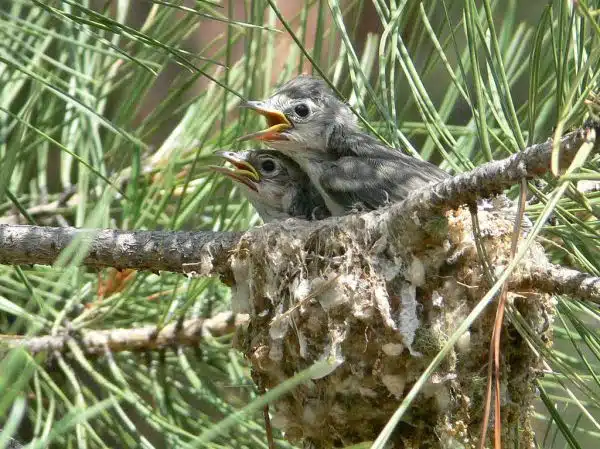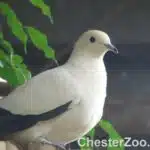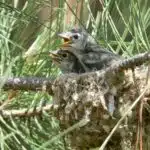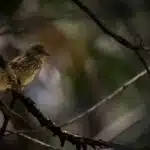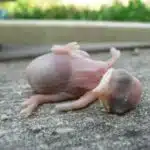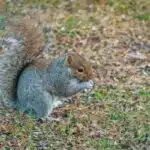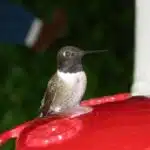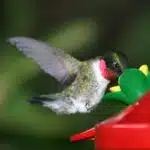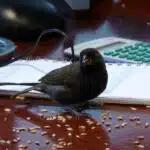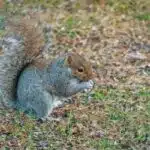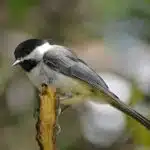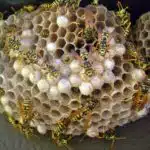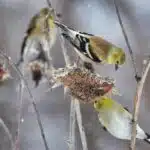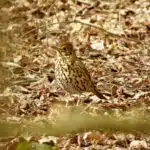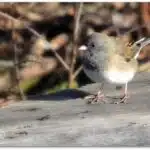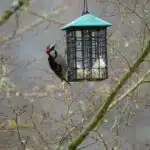The identification of baby birds is a crucial aspect of ornithology and avian biology. It is essential for bird watchers, conservationists, and researchers to identify the species of baby birds accurately to understand the population trends, breeding behavior, and ecology of various avian species. In addition, identifying baby birds is also essential for providing appropriate care to orphaned or injured chicks.
The identification of baby birds can be challenging due to their diverse physical characteristics such as feather patterns, bill shapes, and eye colors. Moreover, many species have different plumages during their juvenile stages than their adult stages. Therefore, it is crucial to have a comprehensive understanding of the physical traits and behavioral patterns of various avian species to identify them accurately. Additionally, knowledge about the habitat preferences and geographic distribution can also aid in the identification process. This article aims to provide an overview of techniques used by ornithologists and bird enthusiasts alike in identifying baby birds accurately.
Importance Of Accurate Identification Of Baby Birds
Accurate identification of baby birds is crucial for various reasons. One of the most important reasons is conservation. Accurately identifying baby birds helps in monitoring and managing bird populations, which is essential for their conservation. By knowing the number and distribution of different bird species, scientists can identify areas that require protection or restoration. Accurate identification also helps in understanding the basic biology and ecology of a particular species.
Furthermore, accurate identification of baby birds can aid in their survival. Different bird species have different feeding and nesting requirements, which means that they require specific habitats to thrive. By identifying baby birds correctly, scientists can determine what habitats are necessary for these birds to survive and reproduce successfully.
In addition to conservation and survival, accurate identification of baby birds can also contribute to our understanding of avian evolution and behavior. By studying how different bird species develop from infancy to adulthood, we can learn about their unique physical characteristics, behaviors, and adaptations that help them survive in their environment. This knowledge is invaluable for researchers studying the evolutionary history of birds.
Identifying baby birds accurately is an essential component in avian biology as it contributes significantly to the conservation efforts being made for these species’ survival. Moreover, it offers insights into the behavior and adaptation strategies adopted by various bird species over time. In the next section, we will delve into some physical characteristics that distinguish baby birds from adult ones.
Physical Characteristics Of Baby Birds
The shape of the beak is one of the most obvious physical characteristics of baby birds. Feathers, body size, and plumage color are also important features to consider when identifying baby birds. In addition, the size of the feet and length of the wings are important factors for identification. Eye and bill color, tail feather length, and the presence of a crop should also be taken into account. Lastly, the strength of the flight muscles and the number of flight feathers and down feathers can provide additional insight into the fledging process.
Beak Shape
Beak shape is a crucial physical characteristic when identifying baby birds. The evolution of beak shape has been shaped by environmental factors, dietary needs, and the bird’s role in the ecosystem. Adaptations in beak shape can indicate whether a species is predatory or herbivorous, as well as its ability to feed on certain types of food.
One example of beak shape adaptation can be seen in the Galapagos finches, where each species has developed a unique beak size and shape to better suit their specific diet. For instance, the ground finch has a thick, sturdy beak for cracking seeds while the woodpecker finch has a thin, pointed beak for probing into tree bark for insects. Another adaptation in beak shape is found in raptors such as eagles and hawks which have sharp curves at the tip of their beaks that allow them to tear apart their prey.
The importance of understanding baby bird’s beak adaptations lies in their survival and reproduction success. By analyzing the morphology of different species’ beaks, ornithologists can determine what they eat and how they acquire it. This information allows us to understand how species interact with one another within an ecosystem and make informed conservation decisions. Therefore, studying baby bird’s physical characteristics such as beak shape is essential not only for avian biologists but also for those who seek to protect and conserve biodiversity.
Feathers
The study of physical characteristics in baby birds is an essential aspect of avian biology. While beak shape is a significant feature, feathers are just as crucial for understanding a bird’s ecology and behavior. Feathers serve multiple functions, including providing insulation, aiding in flight, and displaying courtship behaviors. Ornithologists examine feather anatomy to determine their function and how they grow during different stages of development.
Feathers have unique anatomical features that distinguish them from other types of structures found on animals’ bodies. The central shaft, or rachis, runs through the center of the feather and supports the vane, which consists of interlocking barbs that create a flat surface. The barbs have smaller branches called barbules that hook onto each other to create a cohesive structure. Feather growth occurs in stages: first, the feather sheath covers the developing feather; then, it breaks off once the feather has fully formed.
The growth process of feathers can provide insight into a bird’s life history traits such as age and reproductive status. For example, molt patterns can indicate whether a bird is breeding or not or if it experienced any environmental stressors during its development. Additionally, feathers can retain traces of environmental contaminants such as mercury or lead used to determine exposure levels in birds. Therefore, studying feather anatomy and growth stages is critical not only to understand avian behavior but also for conservation efforts aimed at protecting these fascinating creatures that serve an important role in our ecosystems.
Feet Size
The study of physical characteristics in baby birds is a critical aspect of avian biology. Ornithologists examine various anatomical features to understand their ecology, behavior, and life history traits. While feathers play a crucial role in determining these factors, other structures such as beak shape and feet size are equally important. Feet size, for instance, is an essential feature that can aid in identifying bird classification and understanding their habitat requirements.
Birds’ feet come in different shapes and sizes depending on their species and lifestyle. For example, raptors have sharp talons that they use for hunting, while wading birds have long legs with webbed feet that help them navigate through water bodies. The size and structure of a bird’s foot can also indicate its preferred feeding habits or nesting requirements. Therefore, studying avian anatomy to determine the function of different body parts is essential for identifying and conserving bird species.
Feet size is also crucial for determining a bird’s age or reproductive status. In some species, males have larger feet than females as part of their courtship display. Additionally, monitoring the development of feet during the growth stages can provide insights into environmental stressors or disease conditions affecting the bird population. Hence, incorporating feet size as one of the physical characteristics studied by ornithologists can improve our understanding of avian biology overall.
Feather Patterns And Colors
Feathers play a crucial role in bird identification, with their patterns and colors providing important clues about the species. The feather pattern refers to the arrangement of feathers on a bird’s body, while coloration is determined by pigments or structural properties of the feathers. Feathers can also change over time due to feather molt and environmental factors.
Feather molt is the process of shedding old feathers and growing new ones. This process can affect a bird’s appearance as some species exhibit different plumage during breeding season compared to non-breeding season. Additionally, environmental factors such as diet, pollution, and exposure to sunlight can influence feather coloration. For example, flamingos get their pink coloration from the carotenoid pigments found in their diet of shrimp and algae.
Interestingly, some birds have evolved unique feather patterns for camouflage or mate attraction. For instance, male peafowls have brightly colored feathers that they use during courtship displays to attract females. In contrast, some birds like the potoo have elaborate feather patterns that help them blend into their surroundings and avoid predators. Understanding these nuances in feather patterns and colors can aid in accurate identification of bird species in the field.
Transitioning into “Bill Shapes and Sizes”:
The shape and size of a bird’s bill also plays an important role in identifying different species.
Bill Shapes And Sizes
Feather Patterns and Colors are essential characteristics in identifying bird species, but it is not always enough. Ornithologists also look at other features, such as Bill Shapes and Sizes, to determine the type of bird they are studying. As the famous saying goes, “birds of a feather flock together,” but their bills tell us what they eat.
Types of Bills vary between bird species and have different adaptations for feeding habits. For example, birds with long, thin bills tend to feed on insects or nectar while birds with short, thick bills feed on seeds or fruit. The following list includes some common types of bills:
- Conical bill: cone-shaped with pointed tips; adapted for cracking open seeds
- Decurved bill: curved downward; adapted for extracting nectar from flowers
- Hooked bill: sharp curve at the tip; adapted for tearing flesh from prey
- Chisel-like bill: straight with a flat tip; adapted for chiseling into wood to find insects
Bill Adaptations help birds survive in their respective environments. For instance, pelicans have long bills with a pouch that can hold up to three gallons of water. They use this adaptation to scoop up fish underwater and then drain out the water before swallowing the fish whole. In contrast, toucans have large bills that aid them in reaching fruit high up in trees.
Understanding Types of Bills and Bill Adaptations is crucial when identifying bird species accurately. By examining these features closely, ornithologists can gain insight into a bird’s diet and behavior. The next section will explore another identifying characteristic – Eye Color and Markings – which will further assist ornithologists in their research efforts.
Eye Color And Markings
Eye color and markings are important aspects in identifying bird species. These features can be genetically determined or influenced by environmental factors such as age, sex, and diet. Some birds, such as the American Goldfinch, have different eye colors depending on their age. Juvenile goldfinches have dark eyes while adults have light-colored eyes.
Eye color and markings can also serve as indicators of species evolution. For instance, some birds have evolved to develop distinctive eye markings that enhance their ability to attract mates or deter predators. The Northern Mockingbird has a white iris ring that helps it stand out during courtship displays, while the Barn Owl has a heart-shaped facial disc that helps it locate prey in low light conditions.
In summary, eye color and markings are vital tools in identifying bird species and understanding their evolutionary history. These features can be influenced by genetic factors or environmental influences, but they always play an important role in avian biology. In the next section, we will explore the differences between juvenile and adult plumage and how this relates to bird identification.
Differences In Juvenile And Adult Plumage
As juvenile birds grow and mature, their plumage undergoes a series of changes that eventually lead to the development of adult feathers. Feather development is a complex process that involves both genetic and environmental factors. Juvenile feathers are often duller in color than adult feathers, with less defined patterns and markings. This difference is due to the fact that juvenile feathers lack pigmentation and have a different structure than adult feathers.
Molt patterns also play a role in identifying bird age. Most birds molt their feathers once or twice a year, with juveniles molting more frequently than adults. Age related differences can be seen in the timing and extent of molt, as well as the quality of new feather growth. Seasonal variations also affect feather appearance, with some species undergoing partial molts during breeding season or migration periods.
Understanding these age related differences in plumage can be helpful in identifying bird species. However, it should be noted that behavioral patterns must also be taken into consideration when attempting to identify birds accurately. In the subsequent section, we will explore various behavioral patterns that can aid in bird identification without relying solely on physical characteristics such as plumage.
Behavioral Patterns For Identification
Feeding Habits involve the type and amount of food consumed by a species of bird, often related to the availability of food sources in its habitat. Social Interactions are a vital component of bird behavior, ranging from territorial disputes to courtship rituals. Flight Patterns can provide essential information to the identification of a bird species, such as the shape of the wings, the speed of the flight, and the pattern of movement. Nest Building is an important behavior for many species of birds, and can vary from simple scrapes in the ground to elaborate structures.
Feeding Habits
As avian biologists, we know that understanding the feeding habits of baby birds is crucial in identifying their species. Feeding schedules and parental care are two important factors to consider when observing a baby bird. Different species have unique feeding schedules, with some requiring frequent feedings while others can go longer periods without food.
Parental care also varies among bird species. Some birds exhibit precocial development where hatchlings are mobile and able to feed themselves shortly after hatching. In contrast, altricial birds require intense parental care for several weeks before fledging. The type of food provided by parents also varies between species, with some providing insects while others offer seeds or fruit.
Observing the feeding habits of baby birds can provide valuable insight into their identification. It is important to note that interfering with a baby bird’s natural feeding habits can have negative consequences on their survival. As ornithologists, we encourage individuals who find a baby bird in need of assistance to seek professional help from licensed wildlife rehabilitators who can provide appropriate care and rehabilitation for these young birds.
Social Interactions
Social interactions among birds are another important aspect that avian biologists consider when identifying different species. Birds engage in various forms of social behavior, including aggressive interactions and parental care. Aggressive interactions such as territorial displays and mate competition can provide insight into a bird’s identity. For instance, some species exhibit more aggressive territorial behavior than others, which can help differentiate them from similar-looking species.
Parental care is another crucial aspect of social behavior that ornithologists consider when observing birds. Different species exhibit varying degrees of parental care, with some providing intense care for extended periods while others exhibit minimal parental involvement. Parental care behaviors such as feeding, grooming, and protection can provide valuable information to identify the species of a baby bird.
Observing social interactions among birds provides valuable clues for identifying different species. However, it is important to note that interfering with these natural behaviors can have negative consequences on their survival. As ornithologists, we encourage individuals who encounter birds in need of assistance to seek professional help from licensed wildlife rehabilitators who can provide appropriate care and rehabilitation for these animals while maintaining their natural behaviors.
Habitat Preferences For Different Species
As the saying goes, “birds of a feather flock together.” However, identifying those birds that share similar behavioral patterns can be a challenging task. Fortunately, there are other features one can consider when identifying baby birds, such as their preferred habitat and food sources. These factors can provide valuable insights into the bird’s migratory tendencies and make identification easier.
Migratory tendencies vary between bird species. Some birds migrate to warmer climates during winter months while others remain in the same region year-round. Knowing a bird’s migration patterns can help identify it more accurately. For instance, if you spot a baby bird in the springtime that prefers colder temperatures, it is likely a migratory species that has just returned from wintering elsewhere.
In addition to migration patterns, understanding the preferred food sources of different avian species can aid in identification efforts. For example, seed-eating birds such as finches tend to have thicker beaks than insect-eating warblers. Additionally, certain habitats may provide specific food sources for birds. Wetland areas often attract waterfowl and wading birds that feed on aquatic organisms.
Understanding migratory tendencies and preferred food sources are essential elements to identify baby birds effectively. However, geographic distribution also plays an important role in identification efforts. The distribution of avian species varies widely across different regions of the world due to factors such as climate and topography. In the next section, we will explore how geographic distribution impacts avian species’ identification and highlight some key features to look for when identifying baby birds based on their location.
Geographic Distribution Of Avian Species
The geographic distribution of avian species is an important aspect of understanding bird ecology. Avian migration is a well-known phenomenon, with many species traveling thousands of miles each year to breed and winter in different areas. The timing and route of migration can vary greatly between species, with some birds traveling along specific flyways or stopping at birdwatching hotspots along their journey.
In addition to migration patterns, the geographic distribution of avian species can also be influenced by factors such as climate, habitat availability, and competition with other bird species. For example, some bird species are restricted to specific types of habitats like wetlands or forests, while others can adapt to a wide range of environments. Understanding these factors can help us better predict changes in bird populations and inform conservation efforts.
Birdwatching hotspots are areas where large numbers of migratory birds gather during their annual journeys. These locations provide unique opportunities for bird enthusiasts to observe and document the behavior and distribution patterns of various avian species. By studying the movements and behaviors of migratory birds at these hotspots, we can gain valuable insights into the ecology and biology of these fascinating creatures.
Moving on to our next section on common mistakes in baby bird identification, it is important for novice birders to understand that identifying baby birds can be challenging due to their immature plumage and subtle differences from adult birds. However, with careful observation and attention to key features like bill shape, size, and coloration; eye color; wing shape; and overall body size and shape; even novice birders can become proficient at identifying these young feathered friends.
Common Mistakes In Baby Bird Identification
Identifying baby birds can be a tricky task, even for experienced birdwatchers. Common pitfalls include misidentifying the species or age of the bird, misunderstanding the behavior and vocalizations of the bird, and mistaking fledglings for abandoned nestlings. One of the most common misconceptions in baby bird identification is assuming that all young birds are helpless and need rescuing. In fact, many young birds are perfectly capable of surviving on their own and interfering with them can actually do more harm than good.
Another common mistake is relying solely on physical characteristics to identify a bird, without taking into account its habitat, range, and behavior. For example, two different species of birds may look very similar in terms of coloration and markings but have distinct differences in their vocalizations or preferred habitats. It’s important to use multiple identification features when trying to identify a baby bird.
To avoid these misconceptions in baby bird identification, it’s important to do your research beforehand and familiarize yourself with the species you’re likely to encounter in your area. Use field guides and online resources to learn about each species’ appearance, behavior, habitat preferences, and vocalizations. If you come across a young bird that you’re unsure about, observe it from a distance for a while before intervening. If it appears healthy and alert, it’s likely best left alone.
Tools for Identification
Now that we’ve covered some common pitfalls and misconceptions in baby bird identification, let’s move on to tools that can help you accurately identify young birds in the field. Field guides are an essential tool for any birder or nature enthusiast looking to learn more about local wildlife. These books include detailed descriptions of each species’ appearance, range maps showing where they can be found throughout North America (or other regions), as well as information about their habits and natural history.
In addition to traditional field guides, there are now many apps and online resources available for identifying birds on the go. These tools can be especially useful for beginners or anyone who wants to quickly identify a bird they’ve never seen before. Some of the most popular apps include Merlin Bird ID, iBird Pro, and Audubon Bird Guide. These apps allow you to search by location, size, coloration, and other features to quickly narrow down the possible species. With a little practice and the right tools, identifying baby birds can be a rewarding and enjoyable experience for anyone interested in nature observation.
Tools For Identification, Including Field Guides And Apps
One of the most common mistakes in identifying baby birds is assuming that they are abandoned or in need of rescue when they are not. This can lead to unnecessary human intervention, which can harm the bird and disrupt its natural development. It is important for bird watchers to understand that many species of birds leave their young alone for extended periods of time while they forage for food or engage in other activities.
To avoid making these mistakes, bird watchers should consult field guides and apps that provide accurate information on bird identification. These tools can help identify specific features such as plumage, behavior, and vocalizations that distinguish one species from another. However, it is important to use these tools responsibly and ethically by respecting birding ethics and avoiding disturbing birds unnecessarily.
In addition to improving one’s own knowledge and enjoyment of bird watching, accurate identification also presents opportunities for citizen science participation. By reporting sightings and collecting data on specific species, bird watchers can contribute valuable information to conservation efforts and help protect vulnerable populations. By following these tips for accurate identification in the field, bird watchers can enjoy a rewarding experience while also serving a greater purpose in preserving our natural world.
Tips For Accurate Identification In The Field
Observing and identifying baby birds in the field can be a challenging task, but it is crucial for understanding avian populations. According to recent studies, misidentification of bird species is a common occurrence, with up to 25% of observations being incorrect. Therefore, it is important to follow proper identification protocols to ensure accurate data collection.
Field guide recommendations are an essential tool for accurate bird identification in the field. Properly identifying birds involves observing key characteristics such as size, coloration, markings, and behavior. A good field guide will provide detailed information on these characteristics and help differentiate between similar species. Additionally, familiarity with the local bird species will aid in accurate identification.
Observing vocalizations can also assist in identifying baby birds in the field. Each bird species has its unique vocalization patterns that can be used to distinguish them from other species. Familiarizing oneself with these calls through recordings or birdwatching groups can improve accuracy in identifying avian populations.
Moving forward, it is important to remember that proper identification techniques are critical for studying avian populations accurately. Inaccurate data collection could have significant consequences for conservation efforts and our understanding of bird populations’ ecological roles. In the subsequent section about nest identification and species recognition, we will discuss further methods for increasing accuracy in avian research.
Nest Identification And Species Recognition
Nest construction materials are a reliable means of identifying species as different species use different materials. Nest location also provides clues to species identity, as some species prefer certain habitats. Species markings, such as size, color, shape, and pattern, are also useful for species recognition. The presence of certain feathers, such as down feathers, can also be indicative of species. Furthermore, the presence of certain colored eggs can be used to identify species, as some species lay eggs of differing colors. Finally, the presence of a brood patch, a patch of bare skin on the underside of a bird, can provide clues to species identity.
Nest Materials
The nesting habits of birds are diverse, with some preferring to build their nests on the ground while others opt for high trees. Nesting materials used by birds vary widely and can range from twigs, leaves, grass, bark, feathers, and even mud. The choice of material used is influenced by the bird’s species and habitat.
For instance, cavity-nesting birds like woodpeckers prefer softer materials like wood chips or sawdust, while passerines like warblers use finer materials such as mosses and lichens. Shorebirds often use pebbles, shells, or small stones to line their nests. Additionally, some bird species such as hummingbirds make use of spider silk to bind together soft plant material used in constructing their nests.
The selection of nesting materials can also be influenced by environmental factors such as weather conditions. Some birds like the American Goldfinch wait until late summer when thistle plants produce fluffy seeds that they utilize as nest lining material. In conclusion, the study of nesting materials offers an insight into the ecology and behavior of different bird species during breeding seasons. Understanding this aspect is crucial in identifying various bird species based on their unique nesting behaviors and habitats.
Nest Location
Nest identification and species recognition is a critical aspect of avian biology that helps identify different bird species based on their unique nesting behaviors and habitats. Nest location is an essential component of this process, as it provides valuable information about the ecological needs of various bird species during breeding seasons. The choice of nest location can vary widely among bird species and can range from ground-level burrows to high tree canopies.
The selection of nest locations by birds is influenced by several factors, including availability of suitable nesting sites, protection against predators, and accessibility to food sources. For instance, ground-nesting birds like quails prefer open fields with low vegetation cover for easy access to food and protection against predators. In contrast, canopy-nesting birds like hawks require tall trees with a dense canopy cover for concealment from predators and easier access to prey items.
Moreover, the type of nest material used by birds can also influence their choice of nest location. For example, cavity-nesting birds prefer tree cavities or holes in wooden structures that provide insulation against harsh weather conditions. Conversely, open-cup nesting birds prefer leafy branches or shrubs that offer better visibility and protection against harsh weather conditions. Thus, understanding the relationship between nest material and nesting behavior is crucial in identifying various bird species based on their unique nest locations.
Species Markings
Species identification techniques play a vital role in avian biology as they enable scientists to distinguish between similar species based on their unique physical characteristics. One of the most important such characteristics is the markings or coloration patterns on a bird’s feathers, which can vary widely among species and serve as a critical tool for identifying them. Ornithologists use a variety of methods to study these markings, including visual observation, photography, and spectroscopy.
Visual observation is the simplest and most direct method for studying bird markings. It involves looking at a bird’s feathers under natural lighting conditions and noting any distinctive patterns or colors that help identify it. However, this method has its limitations as some species have subtle markings that are difficult to discern with the naked eye. Therefore, ornithologists often rely on other methods like photography or spectroscopy to obtain more detailed information about these markings.
Photography is an essential tool in avian biology as it allows scientists to capture high-resolution images of bird markings that can be analyzed later using specialized software. This method provides more accurate measurements of feather coloration than visual observation and enables ornithologists to distinguish between similar-looking species more easily. Additionally, spectroscopy is another powerful tool used by scientists to study bird markings by analyzing the chemical composition of feathers using light absorption data. Overall, understanding species identification techniques like these helps researchers better understand different bird species’ behaviors and ecology, which ultimately contributes to conservation efforts aimed at protecting them from extinction.
Caring For Orphaned Or Injured Baby Birds
Having successfully identified the nest and species of a baby bird, the next step is to determine if it requires assistance. Some baby birds may appear orphaned or injured but are actually being cared for by their parents. It is important to observe from a distance for at least an hour before intervening.
If it is determined that the baby bird does require assistance, there are certain caring techniques that can be employed until it can be taken to a wildlife rehabilitation center. The first priority is to keep the bird warm and quiet in a dark, ventilated container. Do not offer food or water as this can cause more harm than good.
Wildlife rehabilitation centers should be contacted immediately for further guidance and care of the baby bird. These facilities have trained professionals who can provide proper nutrition and medical attention as needed. It is important to note that keeping wild animals as pets is illegal and can result in fines or other legal consequences.
Overall, identifying baby birds and determining if they require assistance is an important step in protecting these vulnerable animals. By following proper caring techniques and seeking help from wildlife rehabilitation centers, we can ensure their safe recovery and return to their natural habitats. In conclusion, there are many resources available for those interested in learning more about identifying and caring for baby birds, including local nature centers and online guides provided by reputable organizations such as the Audubon Society.
Conclusion And Further Resources For Identifying Baby Birds
There is no denying that identifying baby birds can be a challenging task, but it is also a rewarding one. The feeling of being able to correctly identify a young bird and watching it grow and mature into an adult is nothing short of exhilarating. However, even the most experienced bird watchers can find themselves struggling to identify certain species.
Fortunately, there are many online resources available that can assist in identifying baby birds. These resources include websites with detailed information on various bird species and their young, as well as forums where birdwatchers can share photos and ask for help in identifying unfamiliar birds. Additionally, many birdwatching communities exist both online and offline, providing opportunities for individuals to connect with others who share their passion for avian biology.
In conclusion, identifying baby birds may seem like a daunting task at first, but with the right resources and support from fellow birdwatchers, it becomes much more manageable. Whether you are just starting out or have been studying avian biology for years, there are always new species to discover and new challenges to overcome. So go out there, join a community of like-minded individuals, and start exploring the fascinating world of baby birds!
Conclusion
Accurate identification of baby birds is crucial for anyone involved in birding, wildlife rehabilitation, or animal rescue. Physical characteristics such as feather patterns and colors, bill shapes and sizes, and eye color and markings are essential in identifying the species of a baby bird. It is important to note that not all baby birds look the same, even within the same species. Therefore, it is essential to observe these physical characteristics carefully to make an accurate identification.
To identify a baby bird accurately in the field, one must also consider its habitat, behavior, and vocalizations. Observing the nest structure and recognizing the parent birds can also aid in identification. In cases where a baby bird is found orphaned or injured, proper care should be taken before releasing it back into the wild.
In conclusion, accurate identification of baby birds is vital for conservation efforts and understanding avian biodiversity. By observing physical characteristics, habitat, behavior, and vocalizations of baby birds in their natural environment or during rehabilitation efforts can help identify different species accurately. Further resources are available online for those interested in learning more about avian biology and conservation efforts. The beauty of these creatures is truly awe-inspiring; every feather on their wings carries with it a world of mystery waiting to be explored by anyone who takes an interest in them.
Image Credits
- “Baby Bird Duo” by Bandelier National Monument (featured)

